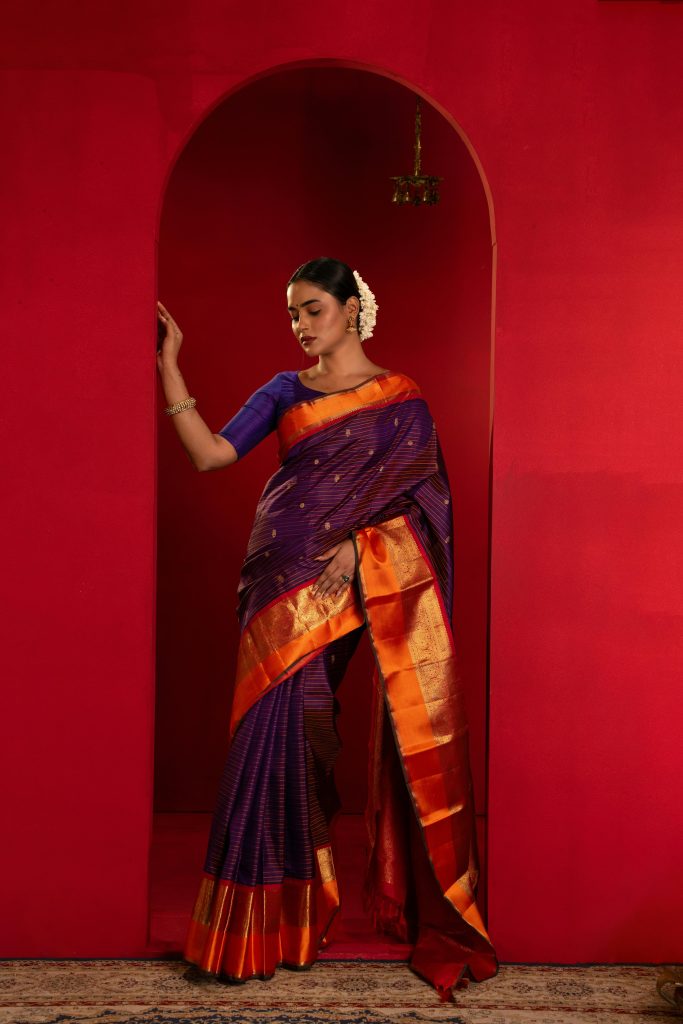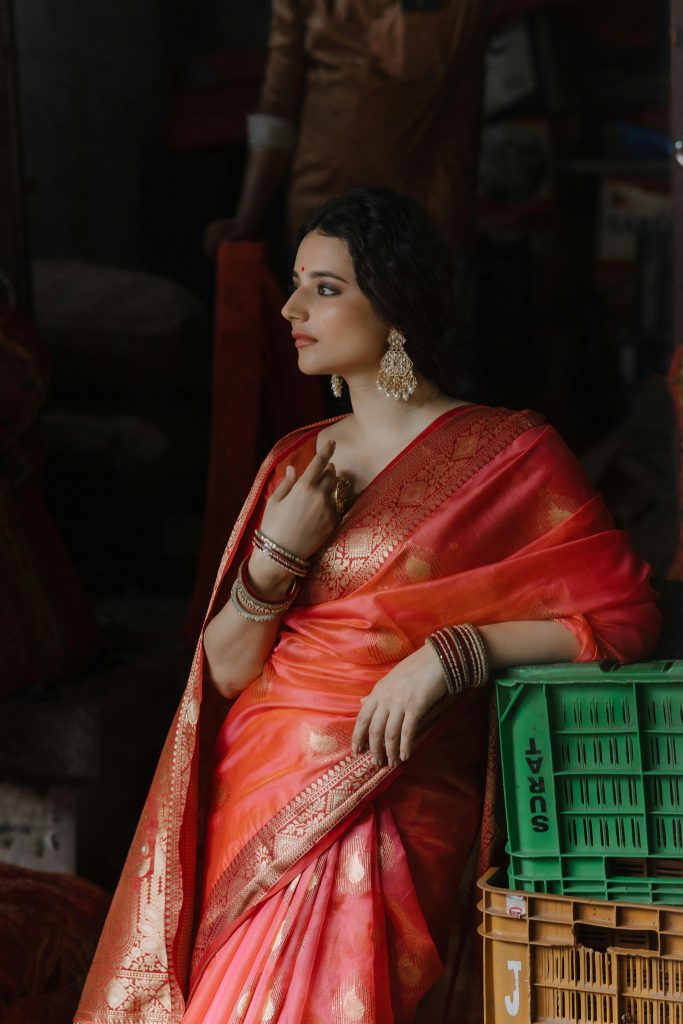A saree is one of the most elegant, traditional, and cultural attires. Whether you are wearing it on a festival occasion, a wedding, or just to represent your culture, it is always a must-learn how to drape a saree. In this guide, we will walk you through the basics of how to a saree, the art of draping it, and caring for it so that it always looks its best.

Know Your Saree Essentials
Before jumping into the techniques of draping, it’s important to understand the key components that make up a complete saree outfit. Here’s a breakdown of the essentials:
1.Banarsi Saree Fabric The Saree fabric, which comes as a yard of cloth up to 5-9 yards in length. Its fabrics come in the range of cotton, silk, chiffon, georgette, and velvet among other varieties that carry their distinct textures, draping, and comfort level for every occasion in accordance with seasons and climate conditions.
2. The Blouse: The blouse should fit well as it helps define the overall silhouette.
3. Petticoat: Petticoats are available in different colors, but it is best to match it with the saree.
4.The Safety Pins: Although not entirely necessary, you can use a few safety pins to pin all the pleats and the pallu in one place. All the more helpful if you happen to that saree long.
Now you have all these things ready for you. Its time to now learn the draping art in steps.

Step-by-Step Guide to Learn the Art of Drape of Banarasi Saree
Draping a saree can seem overwhelming for first-timers, but with the right steps, you can achieve a flawless look. Here’s a step-by-step guide on how to drape your saree in the traditional Nivi style, which is widely preferred for its elegance and ease.
Step 1: Wear the Petticoat and Blouse in Banarasi Saree
Start by putting on the petticoat and blouse. Pull the petticoat tight at the waist to make sure it fits well without any discomfort. The blouse should fit well and go with the fabric of your banarasi saree.
Step 2: Tuck the Saree into the Petticoat
Hold the saree at one end where there are no pleats and shove it into the petticoat on the right side of your waist. Tuck the saree inside your waistline nicely. The more you wrap the saree around your waist, the flatter the fabric will lie.
Step 3: Form Pleats
Now it’s time to create pleats. Start folding the saree from the tucked-in side, making 5-7 neat, equal pleats. Make sure the pleats are of equal width and length to ensure a symmetrical look. Once you’ve created the pleats, gently pin them together with a safety pin to hold them in place.
Step 4: Secure the Pleats in the Center
After making the pleats, tuck them into the waist center, slightly to the left. This will ensure that the pleats fall well in the front. Pin them securely, so they do not come undone.
Step 5: Draping the Pallu
Now, comes the pallu. Take all the remaining fabric after pleating and bring it around your back. Drape the pallu over your left shoulder so that it falls at an appropriate length, ideally ankle or just below.
Step 6: Drape the Pallu
Adjust it perfectly to flow graciously on your shoulder. Make sure you pin it tight. Adjust it at your length choice. You may fold the pallu to a shorter length when it hangs over your hip.
Step 7: Finalizing the Fit
Finally, adjust anything that feels loose or out of place and pin it in with safety pins.
Tips and Tricks for Flawless Draping Banarasi Saree
While it takes time and practice to master the art of saree draping, here are a few tips to make the process easier:
•Use a Full-Length Mirror: It’s essential to drape your saree in front of a mirror so you can see how it’s coming together. You can make necessary adjustments as you go.
•Smooth the Fabric: The Banarasi saree should be draped smoothly, without any bunching or wrinkles. Always ensure the fabric is even as you tuck it into the petticoat and pleat it.
•Pinning is Key: Don’t shy away from using safety pins. They’re essential for keeping the pleats intact and the pallu in place.
•Practice Makes Perfect: If you are a beginner and haven’t worn a saree yet, practice it at home before wearing it to a formal occasion. The more you practice, the easier it will become.
Beyond the Basics: Different Banarasi Saree Draping Styles
Once you master the Nivi style, there are several other ways to drape a saree, each with its own unique charm. Here are a few other popular draping styles:
•Maharashtrian Style: Commonly found in the state of Maharashtra, this is a style of tucking the saree closely around the waist and then forming pleats in front.
•Lehenga Style: lehnga style banarasi saree wearing like that was lehanga
•Mumtaz Style: Inspired by Bollywood star Mumtaz, this way of draping a saree wraps the drape diagonally over the body, thus producing an angular impression
These types can enhance the richness of your collection as it helps to generate newer styles which suit you depending on the occasions.

Care of fashion Banarasi Sarees: Preserving Your Jewel-Encrusted Treasure
A saree is more than just clothing—it’s an investment in tradition and beauty. To ensure your saree remains in pristine condition for years, proper care is essential. Here are some helpful tips for maintaining your saree:
•Wash with Care saree: Always check the care label on your saree.
•Store Properly fashion: To keep your saree looking fresh, store it in a cool, dry place. Avoid hanging it for long periods to prevent stretching. Instead, fold your saree neatly and store it in a cotton bag to protect it from dust.
•Ironing: When ironing, use a low-heat setting for delicate fabrics such as silk. Always use a cloth between the iron and the saree to avoid damage.
•Avoid Sunlight: Prolonged exposure to direct sunlight can cause colors to fade. It’s best to store your saree in a shaded, well-ventilated area.
•Sarees with wear design handled carefully to avoid. Keep them away from rough surfaces or sharp objects.________________________________
Wearing a saree means more than technique in draping; it reflects culture, beauty, and the tradition of each person. Therefore, whether beginner or an experience saree wearer, the comfort, confidence, and style matter. So now, you can flaunt the saree wearing tips and start enjoying its grandeur!